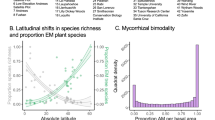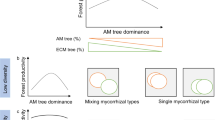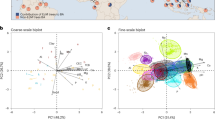Abstract
Ectomycorrhizas and arbuscular mycorrhizas, the two most widespread plant–fungal symbioses, are thought to differentially influence tree species diversity, with positive plant–soil feedbacks favouring locally abundant ectomycorrhizal tree species and negative feedbacks promoting species coexistence and diversity in arbuscular mycorrhizal forests. While seedling recruitment studies and cross-biome patterns of plant diversity and mycorrhizal dominance support this hypothesis, it remains to be tested at the forest stand level over continental scales. Here, we analyse approximately 82,000 forest plots across the USA to show that both ectomycorrhizal-dominated and arbuscular mycorrhizal-dominated forests show relatively low tree diversity, while forests with a mixture of mycorrhizal strategies support a higher number of tree species. Our findings suggest that mycorrhizal dominance, rather than mycorrhizal type, shapes tree diversity in forests.
This is a preview of subscription content, access via your institution
Access options
Access Nature and 54 other Nature Portfolio journals
Get Nature+, our best-value online-access subscription
$29.99 / 30 days
cancel any time
Subscribe to this journal
Receive 12 digital issues and online access to articles
$119.00 per year
only $9.92 per issue
Buy this article
- Purchase on Springer Link
- Instant access to full article PDF
Prices may be subject to local taxes which are calculated during checkout



Similar content being viewed by others
Data availability
The data that support the findings of this study are available from the FIA programme47 at https://apps.fs.usda.gov/fia/datamart/CSV/ENTIRE.zip. The data for the tree mycorrhizal associations are available from Jo and Fei12 with the identifier https://doi.org/10.4231/R76D5R7S.
Code availability
The custom code of the analyses is available at Zenodo48 with the identifier https://doi.org/10.5281/zenodo.5713274.
References
Smith, S. E. & Read, D. J. Mycorrhizal Symbiosis (Academic Press, 2008).
Tedersoo, L., Bahram, M. & Zobel, M. How mycorrhizal associations drive plant population and community biology. Science 367, eaba1223 (2020).
Connell, J. H. & Lowman, M. D. Low-diversity tropical rain forests: some possible mechanisms for their existence. Am. Nat. 134, 88–119 (1989).
Brundrett, M. in Advances in Ecological Research, Vol. 21 (eds Begon M. et al.) 171–313 (Academic Press, 1991).
Allen, E. B. et al. Patterns and regulation of mycorrhizal plant and fungal diversity. Plant Soil 170, 47–62 (1995).
Laliberté, E., Lambers, H., Burgess, T. I. & Wright, S. J. Phosphorus limitation, soil-borne pathogens and the coexistence of plant species in hyperdiverse forests and shrublands. New Phytol. 206, 507–521 (2015).
Bennett, J. A. et al. Plant-soil feedbacks and mycorrhizal type influence temperate forest population dynamics. Science 355, 181–184 (2017).
Teste, F. P. et al. Plant-soil feedback and the maintenance of diversity in Mediterranean-climate shrublands. Science 355, 173–176 (2017).
van der Heijden, M. G. A., Martin, F. M., Selosse, M.-A. & Sanders, I. R. Mycorrhizal ecology and evolution: the past, the present, and the future. New Phytol. 205, 1406–1423 (2015).
Burrill, E. A. et al. The Forest Inventory and Analysis Database: Database Description and User Guide Version 8.0 for Phase 2 (U.S. Department of Agriculture, Forest Service, 2018).
Jo, I., Fei, S., Oswalt, C. M., Domke, G. M. & Phillips, R. P. Shifts in dominant tree mycorrhizal associations in response to anthropogenic impacts. Sci. Adv. 5, eaav6358 (2019).
Jo, I. & Fei, S. Responses of Dominant Tree-Mycorrhizal Associations to Anthropogenic Impacts in the USA (Purdue Univ. Research Repository, 2019).
Read, D. J. Mycorrhizas in ecosystems. Experientia 47, 376–391 (1991).
Laliberté, E., Zemunik, G. & Turner, B. L. Environmental filtering explains variation in plant diversity along resource gradients. Science 345, 1602–1605 (2014).
Ricklefs, R. E. Community diversity: relative roles of local and regional processes. Science 235, 167–171 (1987).
Cleland, D. T. et al. Ecological Subregions: Sections and Subsections for the Conterminous United States. General Technical Report WO-76D (U.S. Department of Agriculture, 2007).
Tedersoo, L. & Bahram, M. Mycorrhizal types differ in ecophysiology and alter plant nutrition and soil processes. Biol. Rev. Camb. Philos. Soc. 94, 1857–1880 (2019).
Taylor, D. L. et al. A first comprehensive census of fungi in soil reveals both hyperdiversity and fine-scale niche partitioning. Ecol. Monogr. 84, 3–20 (2014).
Mariotte, P. et al. Plant–soil feedback: bridging natural and agricultural sciences. Trends Ecol. Evol. 33, 129–142 (2018).
Zemunik, G., Turner, B. L., Lambers, H. & Laliberté, E. Diversity of plant nutrient-acquisition strategies increases during long-term ecosystem development. Nat. Plants 1, 15050 (2015).
van der Heijden, M. G. A. et al. Mycorrhizal fungal diversity determines plant biodiversity, ecosystem variability and productivity. Nature 396, 69–72 (1998).
Maherali, H. & Klironomos, J. N. Influence of phylogeny on fungal community assembly and ecosystem functioning. Science 316, 1746–1748 (2007).
Lin, G., McCormack, M. L. & Guo, D. Arbuscular mycorrhizal fungal effects on plant competition and community structure. J. Ecol. 103, 1224–1232 (2015).
Hartnett, D. C. & Wilson, G. W. T. The role of mycorrhizas in plant community structure and dynamics: lessons from grasslands. Plant Soil 244, 319–331 (2002).
Mangan, S. A. et al. Negative plant–soil feedback predicts tree-species relative abundance in a tropical forest. Nature 466, 752–755 (2010).
Peh, K. S.-H., Lewis, S. L. & Lloyd, J. Mechanisms of monodominance in diverse tropical tree-dominated systems. J. Ecol. 99, 891–898 (2011).
ter Steege, H. et al. Hyperdominance in the Amazonian tree flora. Science 342, 1243092 (2013).
Newman, E. I. & Reddell, P. Relationship between mycorrhizal infection and diversity in vegetation: evidence from the Great Smoky Mountains. Funct. Ecol. 2, 259–262 (1988).
Bahram, M. et al. Plant nutrient-acquisition strategies drive topsoil microbiome structure and function. New Phytol. 227, 1189–1199 (2020).
Beisner, B. E., Haydon, D. T. & Cuddington, K. Alternative stable states in ecology. Front. Ecol. Environ. 1, 376–382 (2003).
Zhu, K., Woodall, C. W. & Clark, J. S. Failure to migrate: lack of tree range expansion in response to climate change. Glob. Change Biol. 18, 1042–1052 (2012).
Phillips, R. P., Brzostek, E. & Midgley, M. G. The mycorrhizal-associated nutrient economy: a new framework for predicting carbon–nutrient couplings in temperate forests. New Phytol. 199, 41–51 (2013).
Jenkins, C. N., Van Houtan, K. S., Pimm, S. L. & Sexton, J. O. US protected lands mismatch biodiversity priorities. Proc. Natl Acad. Sci. USA 112, 5081–5086 (2015).
Chao, A., Chiu, C.-H. & Jost, L. Unifying species diversity, phylogenetic diversity, functional diversity, and related similarity and differentiation measures through Hill numbers. Annu. Rev. Ecol. Evol. Syst. 45, 297–324 (2014).
R Core Team. R: A Language and Environment for Statistical Computing (R Foundation for Statistical Computing, 2018).
Bürkner, P.-C. brms: an R package for Bayesian multilevel models using Stan. J. Stat. Softw. 80, 1–28 (2017).
Dowle, M. & Srinivasan, A. data.table: Extension of ‘data.frame’ R package version 1.14.0 https://CRAN.R-project.org/package=data.table (2017).
Wickham, H., Francois, R., Henry, L. & Müller, K. dplyr: A grammar of data manipulation. R package version 1.0.2 https://CRAN.R-project.org/package=dplyr (2017).
Wickham, H. ggplot2: Elegant Graphics for Data Analysis (Springer-Verlag, 2016).
Kassambara, A. ggpubr: ‘ggplot2’ Based Publication Ready Plots. R package version 3.3.3 https://CRAN.R-project.org/package=ggpubr (2018).
Dunnington, D. ggspatial: Spatial Data Framework for ggplot2. R package version 1.1.1 https://CRAN.R-project.org/package=ggspatial (2018).
Hijmans, R. J. raster: Geographic Data Analysis and Modeling. R package version 3.4-5 https://CRAN.R-project.org/package=raster (2019).
Wickham, H. Reshaping data with the reshape Package. J. Stat. Softw. 21, 1–20 (2007).
Pebesma, E. Simple features for R: standardized support for spatial vector data. R. J. 10, 439–446 (2018).
Wickham, H. & Henry, L. tidyr: Tidy messy data. R package version 1.1.0 https://CRAN.R-project.org/package=tidyr (2019).
Oksanen, J. et al. vegan: Community ecology package. R package version 2.5-6 https://cran.r-project.org/web/packages/vegan/index.html (2017).
Forest Inventory and Analysis; https://apps.fs.usda.gov/fia/datamart/CSV/ENTIRE.zip
Carteron, A. alexiscarter/mycorrhiza_tree_diversity: custom code https://doi.org/10.5281/ZENODO.5713273 (2021).
Acknowledgements
Funding, including scholarships to A.C., was provided by Discovery Grants to E.L. (nos. RGPIN-2014-06106 and RGPIN-2019-04537) by the Natural Sciences and Engineering Research Council of Canada and a Nouveau Chercheur grant (no. 2016‐NC‐188823) by the Fonds de Recherche du Québec sur la Nature et Technologies (FRQNT). A.C. thanks the following institutions for providing generous scholarships: FRQNT (dossier no. 272522) and Université de Montréal through the Bourse d’Excellence Hydro-Québec.
Author information
Authors and Affiliations
Contributions
E.L., A.C. and M.V. conceived the ideas and designed the methodology. A.C., E.L. and M.V. analysed the data and interpreted the results. A.C. led the writing of the manuscript. All authors contributed critically to the drafts and gave final approval for publication.
Corresponding author
Ethics declarations
Competing interests
The authors declare no competing interests.
Peer review information
Nature Ecology & Evolution thanks Marcel van der Heijden and the other, anonymous, reviewer(s) for their contribution to the peer review of this work. Peer reviewer reports are available.
Additional information
Publisher’s note Springer Nature remains neutral with regard to jurisdictional claims in published maps and institutional affiliations.
Extended data
Extended Data Fig. 1 Relationship between ectomycorrhizal (EcM) and arbuscular mycorrhizal (AM) proportions in each plot.
Relationship between ectomycorrhizal (EcM) and arbuscular mycorrhizal (AM) proportions in each plot. 95 % of the plots have a cumulative sum of AM and EcM proportions > 0.99 (that is, most plots are located on the diagonal). Other plots (that is, below the diagonal) contain ericoid or non-mycorrhizal trees. The number of plots in the legend is presented on a log scale.
Extended Data Fig. 2 Map of arbuscular mycorrhizal (AM) proportion per plot.
Map of arbuscular mycorrhizal (AM) proportion (as the proportion of basal area per plot of tree with DBH > 12.7 cm known to associate with AM fungi).
Supplementary information
Rights and permissions
About this article
Cite this article
Carteron, A., Vellend, M. & Laliberté, E. Mycorrhizal dominance reduces local tree species diversity across US forests. Nat Ecol Evol 6, 370–374 (2022). https://doi.org/10.1038/s41559-021-01634-6
Received:
Accepted:
Published:
Issue Date:
DOI: https://doi.org/10.1038/s41559-021-01634-6
This article is cited by
-
Higher productivity in forests with mixed mycorrhizal strategies
Nature Communications (2023)
-
Species diversity of arbuscular mycorrhizal but not ectomycorrhizal plants decreases with habitat loss due to environmental filtering
Plant and Soil (2023)
-
Biomass carbon sink stability of conifer and broadleaf boreal forests: differently associated with plant diversity and mycorrhizal symbionts?
Environmental Science and Pollution Research (2023)
-
The potential of mineral weathering of halophilic-endophytic bacteria isolated from Suaeda salsa and Spartina anglica
Archives of Microbiology (2022)



